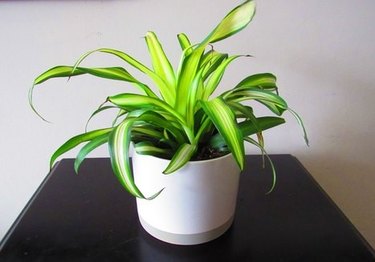
By Teo Spengler, BA, MA, MFA, JD
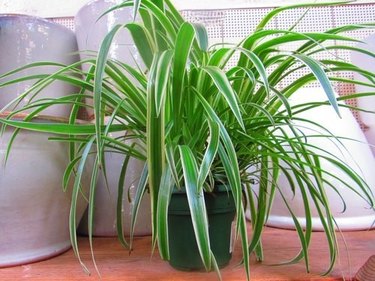
Spider plants win fans for their attractive foliage: long, gently arching leaves growing from a central rosette. The cheerful green leaves — often bearing a white stripe down the center — will lift your mood. And spider plants offer a unique feature: white flowers that dangle on long stems and turn into…miniature spider plants! Each baby "spidie" develops roots and can be clipped and potted for a brand-new plant.
Video of the Day
Video of the Day
Take it from me: You don't have to love spiders to love spider plants! Other than a common name that might "bug" you, these charming, easy-care houseplants have everything it takes to win your heart.
Chlorophytum comosum Highlights
Easy Care?: Yes!
Light + Location: Light shade to bright indirect light
Watering: Water regularly to keep soil evenly moist but not wet
Growth Rate: Moderate- to fast-growing
Flowering: Star-shaped white flowers
Pet-Safe: Yes! But don't encourage pets to chow down on any houseplant.
All About the Spider Plant

Do spider plants encourage arachnids to swarm your home? Absolutely not! The common name reflects the shape of their foliage, each slim leaf—up to 18 inches long—arching gently down from the growing pot. If "spider" bothers you, use one of the other common names, such as "ribbon plant" or "airplane plant."
Spider plants are native to tropical and coastal regions of Africa and can be planted outdoors in mild-winter areas, such as USDA hardiness zones 9 to 11. I live in San Francisco and have planted more than a few of my spider babies in outdoor beds. But they can be messy outside. They make such impressive container plants that cultivating indoors is always my first choice.
When you see the spider plant's long, lovely leaves, you might think they would appreciate a direct sun location. But I can tell you from experience that this is not a good idea. You will get crispy leaf tips and might even kill off the plant.
Spider Plant Care

Whenever a friend asks me for a hard-to-kill plant to send with their kid to college, I suggest a spider plant. As long as you don't bake these plants in direct sun, they are tolerant and forgiving. They thrive in low-light areas, accept irregular irrigation, and require no pruning or fertilizer.
The key to a long-lived, healthy spider plant is setting it up correctly to meet its basic cultural requirements. That means a location out of direct sun, a container with good drainage, quality potting soil that drains well, and adequate water. Let's talk a bit more about each of these requirements.
Best Location for Spider Plants
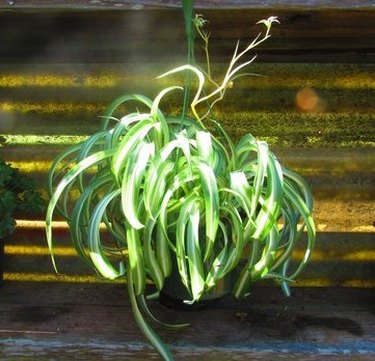
You can grow spider plants outdoors in warm hardiness zones, but in my experience, they tend to look muddled. Outdoor plants also tend to spread as their spider babies land on the soil and take root.
Containers indoors keep the plants from spreading and allow the stalks to hang gracefully. Choose a spot with medium to bright indirect light. Low-light areas will suffice, but the leaf color and variegations fade in truly dim areas. Select a site that is far from a heater or air conditioner—almost all houseplants prefer stable temperatures.
Best Containers for Spider Plants
This plant looks thrilling in a hanging basket, where its grassy foliage and flower stalks—later baby spiders—can spread out in midair in all sides. But any container with drain holes works just fine, with terra-cotta pots winning the race by a nose, given that they absorb excess water. Insider tip: Placing that container on a pedestal will give it much of the same sex appeal as a hanging basket.
Potting Soil for Spider Plants
Spider plants need good drainage and will die in water-logged soil. So select a classic, loamy potting soil with a neutral pH and you are good to go.
Air Temperature and Humidity for Spider Plants
If you set your home's thermostat at a level that makes you comfortable, the spider plant will be happy too. Average household temperatures are just fine, and the plant will enjoy an outing on warm afternoons, but don't leave them out when temps drop below 50 degrees F.
What about humidity? These houseplants do like moist air, and misting them every now and then may help. Though they can thrive in a bathroom, they manage just fine in my very dry bedroom. I take them outside for a hose shower from time to time, cleaning the leaves and offering humidity at the same time.
How Often to Water Spider Plant
With spider plants, it's important to talk about both their ideal watering schedule and the watering schedule they will accept. Ideally, regular watering is best. The plants prefer evenly moist soil to wet or dry soil.
However, dry is far better than wet—consistently wet soil can kill the plants. That's why spider plants are good for offices and college dorms: Watering every week is great, but these tolerate plants do just fine if you remember to pick up the watering can every two weeks.
Spider Plant Fertilizer
Fertilizing a spider plant is not essential, but it can help your plant grow faster and stay vital. If you decide to fertilize, use a balanced liquid fertilizer on a monthly basis during spring and summer only. Too much of the stuff will turn the leaf tips brown.
How to Propagate Spider Plant
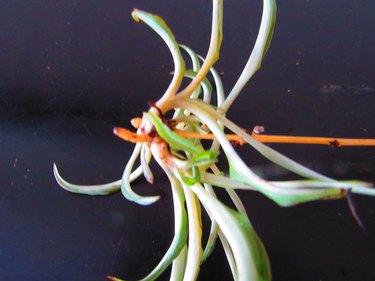
Divide and conquer? Or wait for the babies? I personally adore the little spidies. Speaking strictly for me, the spider plant experience wouldn't be the same if I didn't propagate from spidies. It's so easy, even a child can do it.
If that's your choice too, here's how to proceed. As your plant matures, you'll see it grow long stems tipped with starry white flowers. Once the flowers are done, you'll see the baby spiders—little spider plantlets—form in their place and, still attached to the stems, grow roots. After the roots grow a few inches, snip off the plantlets with pruners, then plant each spidie in potting soil in a little container. Keep the soil moist until you see new growth.
The alternative for propagation, division, is arguably easier, but, to my mind, less fun. Just tip out a container plant, pull or cut the root ball into sections, then replant each one.
Repotting Spider Plant

Spider plants grow fairly quickly, and though it's the leaves you see lengthening, the roots are growing too, down under the soil. Change the pots every few years, or whenever you see roots snaking out of the drain holes or pushing up above the soil line. Repot in spring, selecting a container about a third larger than the current root ball.
The how-to is the same as for most houseplants. Slip the soil ball out of the pot to see whether the roots are crowded. If they are, select a larger pot, add some inches of soil, set the old root ball on that soil, and tuck in more soil around the sides. Don't pack it in up to the top of the container. Leave an inch or two free to make watering a breeze.
Types of Spider Plants
Do you want variegated leaves, green leaves, curly leaves? There's more than one type of spider plant to consider.
Chlorophytum comosum 'Vittatum'
'Vittatum' is the most popular of the spider plant cultivars, the one you see most often in the garden store. Its slender green leaves have white stripes running right down the middle.
Chlorophytum comosum 'Hawaiian'

'Hawaii' has similar white and green coloring, but the leaves are wider. The leaves may also curl instead of gently arching.
Chlorophytum comosum 'Variegatum'
Do you prefer your spider plants with white edging on the leaves instead of a white stripe in the center? Now you see why 'Variegatum' is also called the "Reverse Spider Plant."
Chlorophytum comosum 'Green Shamrock'
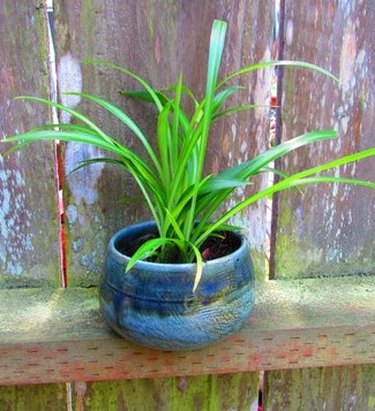
The perfect spider plant to offer on Saint Patrick's Day, the 'Green Shamrock' is solid green. The leaves are about the color of jade, and the plant leans toward elegant rather than cheerful.